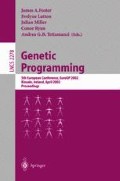Abstract
We present the system SIGEL that combines the simulation and visualization of robots with a Genetic Programming system for the automated evolution of walking. It is designed to automatically generate control programs for arbitrary robots without depending on detailed analytical information of the robots ’kinematic structure. Different fitness functions as well as a variety of parameters allow the easy and interactive configuration and adaptation of the evolution process and the simulations.
Access this chapter
Tax calculation will be finalised at checkout
Purchases are for personal use only
Preview
Unable to display preview. Download preview PDF.
References
C. Aue, A. Benkacem, M. Gregorius, A. Ross, S.R. Abdallah, D. Sawitzki, V. Strunk, H. Türk, M.C. Varcol, J. Busch, and J. Ziegler. Simulator für GP-evolvierte Laufrobotersteuerungsprogramme-PG 368. Technical report, Department of Computer Science, University of Dortmund, Germany, 2001.
W. Banzhaf, P. Nordin, R.E. Keller, and F.D. Francone. Genetic Programming. An Introduction; On the Automatic Evolution of Computer Programs and its Applications. Morgan Kaufmann, dpunkt.verlag, 1998.
V. Braitenberg. Vehicles: experiments in synthetic psychology. MIT Press, 1984.
R.A. Brooks. New approaches to robotics. Science, 253:1227–1232, 1991.
H. Cruse. Coordination of leg movement in walking animals. In From animals to animats. Intl. Conf. on Simulation of Adaptive Behavior, pages 105–119, 1991.
P. Dittrich, A. Bürgel, and W. Banzhaf. Learning to control a robot with random morphology. In Proceedings Evo-Robot-98, P. Husbands and J.-A. Meyer, Eds., pages 165–178, 1998.
S. McMillan et al. DynaMechs (Dynamics of Mechanisms): A Multibody Dynamic Simulation Library. Ohio State University Internet Access (last access 22.08.2001)via http://dynamechs.sourceforge.net/.
J.J. Grefenstette and A.C. Schultz. An evolutionary approach to learning in robots. In Machine Learning Workshop on Robot Learning, New Brunswick, NJ, 1994.
M. Komosinski and S. Ulatowski. Framsticks-Artificial Life. In ECML’ 98 Demonstration and Poster Papers, Chemnitzer Informatik Berichte, pages 7–9, 1998.
J.R. Koza. Genetic Programming. MIT Press, Cambridge, MA, 1992.
M.A. Lewis, A.H. Fagg, and A. Solidum. Genetic programming approach to the construction of a neural network control of a walking robot. In Proceedings of the 1992 IEEE InternationalConference on Robotics and Automation, pages 2618–2623, Nice, France, May 1992.
J.-A. Meyer. Evolutionary approaches to walking and higher-level behaviors in 6-legged animats. In Gomi, editor, Evolutionary Robotics II: From Intelligent Robots to Artificial Life (ER’ 98). AAAI Books, 1998.
M. Olmer, W. Banzhaf, and P. Nordin. Evolving real-time behavior modules for a real robot with genetic programming. In Proceedings of the international symposium on robotics and manufacturing, Montpellier, France, May 1996.
Karl Sims. Evolving virtual creatures. In Andrew Glassner, editor, Proceedings of SIGGRAPH’ 94 (Orlando, Florida, July 24–29, 1994), Computer Graphics Proceedings, Annual Conference Series, pages 15–22. ACM SIGGRAPH, ACM Press, July 1994. ISBN 0-89791-667-0.
G.F. Spencer. Automatic generation of programs for crawling and walking. In S. Forrest, editor, Proceedings of the 5th International Conference on Genetic Algorithms, ICGA-93, page 654, University of Illinois at Urbana-Champaign, 17–21 July 1993. Morgan Kaufmann.
J. Ziegler and W. Banzhaf. Evolution of robot leg movements in a physical simulation. In K. Berns and R. Dillmann, editors, Proceedings of the Fourth International Conference on Climbing and Walking Robots, CLAWAR, pages 395–402, Bury St Edmunds, London, UK, 2001. Professional Engineering Publishing.
Author information
Authors and Affiliations
Editor information
Editors and Affiliations
Rights and permissions
Copyright information
© 2002 Springer-Verlag Berlin Heidelberg
About this paper
Cite this paper
Busch, J., Ziegler, J., Aue, C., Ross, A., Sawitzki, D., Banzhaf, W. (2002). Automatic Generation of Control Programs for Walking Robots Using Genetic Programming. In: Foster, J.A., Lutton, E., Miller, J., Ryan, C., Tettamanzi, A. (eds) Genetic Programming. EuroGP 2002. Lecture Notes in Computer Science, vol 2278. Springer, Berlin, Heidelberg. https://doi.org/10.1007/3-540-45984-7_25
Download citation
DOI: https://doi.org/10.1007/3-540-45984-7_25
Published:
Publisher Name: Springer, Berlin, Heidelberg
Print ISBN: 978-3-540-43378-1
Online ISBN: 978-3-540-45984-2
eBook Packages: Springer Book Archive

